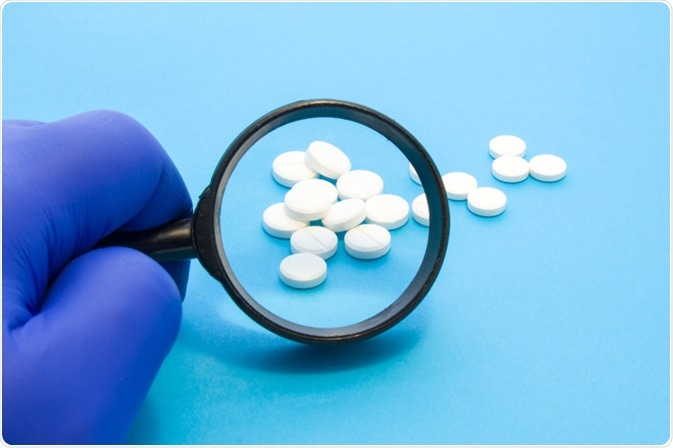Over the past 10 years, many countries have had to manage the emergence of new psychoactive substances (NPS). These recreational drugs are similar to existing illegal substances in terms of their effects or structure.

Image Credit:Shutterstock/Shidlovski
When these substances first appeared, they were able to exploit loopholes in the drug laws of many jurisdictions because, as they were new substances, they had not yet been scheduled.
These exploits resulted in a highly ‘cat and mouse’ situation whereby, when one NPS had been identified and appropriately scheduled by the authorities, a similar substance with small structural changes would then appear on the market, taking the place of the newly scheduled substance.
Significant adverse effects and fatalities have been linked to the consumption of NPS. Their safety is especially concerning, because there are signs that inexperienced drug users are uniquely drawn towards them due to their ‘legal’ status.
Overall, NPS is the fastest growing class of recreational drugs. Most of these take the form of synthetic cannabinoids, and these were initially marketed as ‘Spice’, which first appeared in 2008. They are also occasionally referred to as ‘designer drugs’ or ‘fake pot’.
New laws emerge
Many countries have addressed this issue with new NPS-specific laws, and these laws have taken various approaches. Under these new laws, drugs not currently scheduled under a country’s primary narcotics legislation, can still be considered illegal based on their chemical structure, (as implemented by Croatia, Germany, Turkey and Australia) or their psychoactive effects (as implemented in the United Kingdom, Austria and Ireland).
The Neue-psychoaktive-Stoffe-Gesetz (NpSG) was introduced in Germany in November 2016. This law approached the issue by classifying substances based on four structural elements: linker, linked group, core and sidechain.
When this law was introduced, its definition covered all the NPS already identified and scheduled by Germany, alongside 87% of NPS which had been monitored by the European Monitoring Centre for Drugs and Drug Addiction.
In the Summer of 2018, researchers began looking at samples of ‘spice-like’ drugs available from German-language online shops. They assessed these to ascertain their active ingredients, with a view to providing a clear picture of the country’s synthetic cannabinoid market.
Not previously identified
This study (Ernst et al., 2019) analyzed 15 samples of herbal mixtures acquired from four German-language online shops, and each sample was analyzed using gas chromatography-mass spectrometry.
The study’s results identified three active ingredients. Two of these active ingredients were already known - Cumyl-PeGaClone and 5F-ADB – while the third ingredient was found to be the previously unidentified 5F-Cumyl-PeGaClone.
Next, the researchers performed in-depth analysis on this compound using electrospray ionization tandem mass spectrometry, electron ionization mass spectrometry, nuclear magnetic resonance spectroscopy, and infrared-/ultraviolet-visible spectroscopy.
They learned that each sample contained a single active ingredient and in 12 of the 15 samples, this active ingredient was the newly identified 5F-Cumyl-PeGaClone. Using NMR analysis, the researchers were able to verify the compound’s structure, confirming that it is structurally very similar to the previously described Cumyl-PeGaClone, exhibiting only minor differences.
The compound was also observed to be similar to an existing NPS (5F-ADB) that had recently been scheduled under Germany’s core narcotics law, though this compound was found in only one of the samples obtained for the study.
The structural elements common to 5F-ADB and 5F-Cumyl-PeGaClone had not yet been listed under the NPS-specific law, however, meaning the suppliers were able to successfully exploit a loophole in the legislation, facilitating the legal distribution of the product.
The researchers were concerned that, while most of the samples were found to contain the same active ingredient, the doses varied considerably, ranging from 17 to 76 mg/G. Despite this, the packaging did not include any indication of potency for the user.
By utilizing the data, the team was also able to approximate the potential profit return on these particular products, estimating it to be between 3.3 to 42.5-fold of costs. While potentially extremely dangerous to consumers, the NPS business is highly lucrative for suppliers.
Unsurpassed performance
The study’s NMR analyses were performed using a Bruker AVANCE NMR spectrometer fitted with a TCI triple resonance ‘inverse’ probe.
The most advanced Bruker AVANCE NEO spectrometer offers notable, unparalleled NMR performance due to its unique transceiver architecture. Each NMR channel functions independently, effectively performing RF generation, transmission and receive. This enables each channel to essentially work as a spectrometer, creating the opportunity to perform multi-receive experiments while delivering enhanced flexibility.
A distinct acquisition server and operating system, complemented by Bruker’s industry-standard software TopSpin, means that the AVANCE NEO can function independently from the computer, even being controlled from the cloud where required.
References
- Halter S, Haschimi B, Mogler L, et al. Impact of legislation on NPS markets in Germany – the rise and fall of 5F-ADB. Drug Testing & Analysis 2020; doi: 10.1002/dta.2786.
- Kraemer M, Boehmer A, Madea B, et al. Death cases involving certain new psychoactive substances: A review of the literature. Forensic Science International 2019; 298: 186-267. doi: 10.1016/j.forsciint.2019.02.021.
- Ernst L, Langer N, Bockelmann A, et al. Identification and quantification of synthetic cannabinoids in 'spice-like' herbal mixtures: Update of the German situation in summer 2018.Forensic Science International 2019; 294: 96-102. doi: 10.1016/j.forsciint.2018.11.001.
About Bruker BioSpin - NMR, EPR and Imaging

Bruker BioSpin offers the world's most comprehensive range of NMR and EPR spectroscopy and preclinical research tools. Bruker BioSpin develops, manufactures and supplies technology to research establishments, commercial enterprises and multi-national corporations across countless industries and fields of expertise.
Sponsored Content Policy: News-Medical.net publishes articles and related content that may be derived from sources where we have existing commercial relationships, provided such content adds value to the core editorial ethos of News-Medical.Net which is to educate and inform site visitors interested in medical research, science, medical devices and treatments.